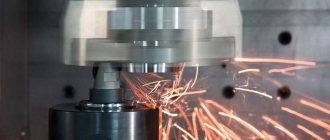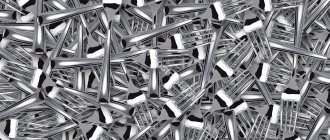This tool is divided into tools for filing, chopping and punching
impact and auxiliary tools.
Tool for filing the surfaces of metal workpieces
- rasps, files, needle files. These tools are distinguished by cross-sectional shape, size, type of cut and size of teeth.
Rasps are bars with a cross section of various shapes, on the working surface of which a pitted notch with pyramidal protrusions is applied.
The protrusions are arranged in a checkerboard pattern. Rasps are used for rough processing of soft materials: aluminum, lead, wood, plastics, rubber, etc.
Files
The cross-sectional shape can be flat, square, triangular, rhombic, hacksaw, round, semicircular. All files, except round ones, are made with a notched tooth, round ones - with notched and threaded ones.
Files with large teeth are called bastard
(length 200-300 mm), with medium -
personal
(length 150-200 mm) and with small -
velvet
(length 100-125 mm).
Files
According to the cross-sectional shape, they are produced in ten types - flat, round, square, triangular, etc. The length of the working part of the files can be 40, 60 and 80 mm. The files have a cross (double) notch.
Files and needle files must be heat-treated and have a hardness that ensures their adhesion to the control plate with a hardness of HRC 57. A decarburized layer is not allowed on the tops of the teeth. The non-straightness of the working part is no more than 0.2 mm per 100 mm of length.
Tool for cutting metal and punching holes
- chisels, crosscutters, beards.
Chisels
used for metalworking of unhardened metal. They are steel rods with a wedge-shaped working part, a sharpening angle of the cutting edge from 35 to 70° and a width from 5 to 20 mm. Chisels are produced with a total length of 100 to 200 mm.
Kreutzmeiseli
used for cutting narrow grooves with a width of 2 to 15 mm.
Beards
used for punching holes in sheet material. They are manufactured with a conical and cylindrical working part. The diameter of the hole to be punched depends on the size of the end part of the bit and can be from 1 to 8 mm.
Chisels, crosscuts, and bits must have a hardness of the working part HRC 53-59, and a hardness of the striking part HRC 35-45.
Drilling tool for metal
— drills and drills — used to make holes during manual processing.
Drill
consist of a working part and a shank. The working part has a spiral shape and ends with a cutting edge. When drilling, chips are discharged along spiral grooves
The drill is used to rotate the drill. When drilling, the drill is clamped into a chuck, which is driven into rotation using a bevel gear, which increases the rotation speed.
Tools for cutting threads - taps, dies, wrenches.
Taps
are used for cutting threads in holes of parts, nuts, pipes, etc. A tap consists of a working part and a shank for securing it in the driver during operation. The working part is in the form of a screw with longitudinal grooves (3-4). The cutting part of the tap is made in the form of a cone for entering the hole to be cut, which turns into a cylindrical gauging part. Cutting is carried out using threaded turns of a tap
Dies
designed for cutting threads on the outer surfaces of bolts, screws, pipes. The dies can be round, solid or slotted (so-called dies), prismatic, sliding with a screw thread in the internal cavity. Dies are available with metric and pipe threads.
Collars and cleats
used for installing and securing taps and dies when cutting threads.
The drivers in the middle thickened part have square holes for attaching to the tap shank or a clip for securing a round die. Read also: How to disassemble an Interskol R 102 1100em plane.
The blocks have a rectangular cage in which the split dies are secured.
Tools for cutting metal - hacksaws and scissors.
Hacksaws for metal
consist of a hacksaw blade and a machine with holders for securing the blade. Hacksaw machines are made sliding, allowing you to fasten blades with dimensions of 250-350 mm.
Metal scissors
used for cutting thin sheet metal. They are divided into manual and chair. Scissors are made all-steel or with welded blades. The scissors must be heat treated and have a hardness of HRC 52-58.
Percussion instrument
- sledgehammers (used for plastic deformation of metal and giving it a certain shape), carpentry, roofing and metalworking hammers.
Auxiliary tool
- vices, anvils, bench presses - used when performing metalworking work on processing workpieces and when finishing parts to the required sizes.
Vise
are a tool that is used to hold and secure metal workpieces during metalwork (filing, chopping). Vices are produced in manual and tabletop types; tabletops can be chair or parallel.
Anvils
used in blacksmithing for forging metals, straightening, bending, and also for metalwork.
Bench crimping
used to obtain permanent connections using rivets. They serve for molding the closing heads and have a crimping hole on the end surface.
Metalworking tools are designed to give workpieces the required shape by cutting or abrasive action with the removal of chips or parts of metal. Most types of tools can be used without practical experience.
Types of hand tools by purpose
During the repair process, a craftsman may need various metal work: bending, chopping, drilling, filing, threading.
Solving the listed problems is possible using specialized plumbing tools, which are always at hand. Based on its purpose, it can be divided into several main groups. Below we will look at where each device is used. Impact and marking tools:
- Machinist's hammers and blacksmith's sledgehammers are used in many technological operations: chopping, bending, straightening.
- Punch punches are used to mark metallic as well as non-metallic materials.
- Chisels are used to cut metal.
- Crosspieces allow you to cut out keyways and grooves. They differ from chisels in having a narrower cutting edge.
- Using scribers and compasses, precise marking work is carried out.
- The bits are designed for punching holes in sheet metal.
In the process of performing plumbing and assembly operations, various pliers are used. This includes pliers, pliers, round nose pliers, tongs, and pliers. A bench vice is used to fix parts for subsequent processing.
Thread cutting tool:
External threads are cut with dies, internal threads with taps. Die holders and wrenches are devices for rotating hand-held thread-cutting tools.
Devices for cutting and machining metal:
Files and needle files are used for filing parts and workpieces. Hacksaws are used to cut sheet and profile metal, and also perform other types of work. Hand shears are designed for cutting sheet metal. Thin layers of material are removed from parts using scrapers. As a result of scraping the mating surfaces, their tight fit and tightness are ensured.
Hole making tool:
- Holes in the workpieces are made using drills. They are made from alloyed carbon steels.
- Reamers allow high-precision machining of cylindrical and conical holes.
- Countersinks are used to process recesses and chamfers of drilled holes for the heads of screws, bolts, and rivets. Using counterbores, the end surfaces are cleaned.
- Countersinks are used to increase the diameters of drilled holes, improve their accuracy and quality.
Tool for assembling threaded connections:
- Spanners. By design, they can be horn or cap, end, hinged, adjustable, ratchet. Choosing the right version ensures ease of work in hard-to-reach places.
- Torque wrenches allow you to adjust the tightening force of fasteners.
- Plumber's screwdrivers for screws and screws with straight or Phillips slots are indispensable in production, construction, and repair.
Measuring devices include:
- Rulers, roulettes.
- Vernier tool. This includes calipers, height gauges and depth gauges.
- Micrometric instruments, bore gauges.
- Length measures: plane-parallel end, angular prismatic, line.
- Test plates, probes, straight edges, squares.
- Radius and thread templates.
- Instruments for measuring angles: protractors, levels, sine rulers.
- Indicating devices.
Thus, hand tools allow you to solve most problems when working with metal.
Recommendations for choosing a sheet bending tool. Part I
Many people believe that the bending tool does not play a big role in the metal bending process, when in fact the opposite is true. Although press brakes have evolved over the years into multi-axis precision machines with self-stabilizing features, the press brake is the only thing that actually shapes the workpiece during bending (see Figure 1).
The line between which standard (American, European, New or RFA standard) a tool meets has become blurred. Many of the functions required for high-performance bending have come to be used in a wide variety of tool types. No matter what tool or clamp type you choose, it must meet at least a few minimum requirements.
High accuracy.
Tools must be manufactured to a tolerance not exceeding 0.01 mm. It is extremely important to ensure the accuracy of manufacturing the part without resorting to all sorts of tricks when setting up the machine, for example, using gaskets, etc.
Segmented sections.
This tool structure makes it possible to produce parts of various lengths, composed of several pre-cut parts. In addition, working with small parts is easier and safer.
Self-holding installation.
It is necessary to ensure that tools can be loaded with the press cross-beam raised. The tool holder system must hold multiple tools in place until clamping force is applied (see Figure 2).
Self-centering.
After applying clamping force, the punches are mechanically set to their working position. This eliminates the need to lower the punch into the die during setup.
Front loading.
It is necessary to ensure that tools can be installed at the front of the press. This reduces setup time because there is no time spent moving tools from the back of the press brake. In most cases, front loading also eliminates the need for forklifts and overhead cranes.
Standard sizes.
Standard-height tools allow you to reduce the amount of work required to reconfigure the press when moving to another workpiece. The front supports, rear supports and safety devices remain in their normal positions. And since all tools are standard heights, you can add pre-made workpieces with confidence that they can be processed with your existing tools.
Many high quality sheet metal bending tools are made to metric standards. Thus, a V-shaped matrix with a nominal channel size of 6.3 mm has an actual size of 6 mm. Moreover, sheet metal bending areas have a slightly elliptical corner radius shape, so that all you need to do to get the correct shape is to move the tool closer to the bend. For simplicity, dimensions in inches are rounded.
The following article focuses on air bending, and for good reason. The general trend is to move away from press bending or stamping in favor of air bending whenever possible. Please remember, however, that not all parts can be made using conventional air bending methods.
Rice. 1. Tooling plays a vital role in ensuring the precision of parts.
Operators across the industry use a wide variety of tools to produce parts of comparable or identical quality. Many operators produce acceptable quality parts using the wrong tools because they don't have the right ones. They strive for quality; However, in this case, “achieving quality” does not mean producing parts with high efficiency and repeatability, and, in addition, such an approach can seriously disrupt the workflow. Best practice for tool selection should really be based on a simple goal: delivering the best quality parts in the least amount of time.
A systematic approach to choosing the necessary tool.
A maintenance facility uses (and requires) different bending tools than a custom parts manufacturer. So, before going into details, be clear about your needs and budget constraints.
For example, you may need additional tools to reduce setup time. Perhaps you are a lean manufacturing business that benefits from having separate tool sets for each press brake and therefore are willing to invest in identical tool sets for each machine. This way, when setting up the press, valuable time is not wasted searching for the required tool in the tool box or elsewhere. An additional advantage of this option is that there is no need to ensure compatibility between the types of tools used on different presses, since the tools are, for the most part, used on the machines for which they were purchased (see Fig. 3).
If you need to purchase additional (duplicate) tools to expand the range of tools available in each press's own toolbox, selecting them is quite simple. Often these tools are located in convenient locations for the operator or are already available in the press brake toolbox. Look for tools with the most visible signs of wear: the working surfaces of these tools are light and shiny. The bodies of these instruments are also likely to be clean and shiny. It is unlikely that the tools being sought are rusty, dirty tools lying at the bottom of a drawer.
Matrix selection
To get the most bang for your buck, select the minimum number of lower dies that will allow you to bend any thickness of metal within the range your equipment can handle. Businesses with little experience, custom orders, or those with limited funds should select bottom dies using the 8x2 rule.
First, determine the thickness range of the metal you are going to bend. For example, you expect to work with metal with a thickness of 0.8 to 6.4 mm.
Second, calculate the size of the smallest V-die required by multiplying the minimum metal thickness by 8. In our example, the smallest die would be needed to bend 0.8mm thick metal. Hence: 0.03 × 8 = 0.24 inches, which we round up to 0.25 (6.4 mm).
Third, calculate the size of the largest V-die required by multiplying the maximum metal thickness by 8. In our example, the largest die required to bend 0.25-inch-thick metal: 0.25 × 8 = 2
Thus, you have determined the size of the smallest and largest matrix required: 0.25 and 2 inches, respectively. To determine which matrices are required between these limits, take the smallest V-shaped matrix and double its size. In our example, we get a matrix measuring 0.5 inches (0.25 × 2 = 0.5) or 12.7 mm. Next, by doubling a 0.5-inch matrix, we get a 1-inch matrix, and then, doubling this size again, we get a 2-inch matrix. Thus, we have a minimum set of four different V-shaped dies required for bending metal with a thickness of 0.03 to 0.25 inches (0.8–6.4 mm): 0.25 / 0.5 / 1.0 and 2.0 inches.
Rice. 2. Tools are held in place while the clamping mechanism is open.
Punch selection
The thickness of the material is also used to determine the minimum number of upper dies (punches). For bending material 0.187 in. (4.7 mm) thick and thinner, a pointed punch (offset) with a 0.04 in. (1 mm) radius can be used. The sharp angle allows you to bend at an angle greater than 90 degrees, and the offset allows you to create J-shaped profiles. For bending material thicknesses ranging from 0.187 to 0.5 inches (4.7 to 12.7 mm), a straight punch with a radius of approximately 0.12 inches (3 mm) is recommended to withstand increased loads.
Please note that when using common industry standards for some parts, including thicker and higher-strength parts, the workpiece folds often become wrinkled, cracked, or even broken. This is explained by the laws of physics. A narrow punch face means more force at the fold line, and with a narrow V-shaped die, this force increases even more. For difficult-to-manufacture parts, and especially when using stock thicker than 0.5 in. (12.7 mm), it is best to consult the material supplier for advice on the recommended punch nose radius.
Rule of 8
In an ideal world, you could use what we call the rule of 8s to select a V-shaped matrix, i.e. The V-die channel must be 8 times the thickness of the material. To select a die, multiply the material thickness by 8 and select the die with the size closest to the calculated value. Thus, if the material thickness is 0.06 inches (1.5 mm), a die of 0.5 inches will be required (0.06 × 8 = 0.48; 0.50 inches is the closest die width to the design value); a 0.125 inch (3.2 mm) thick material would require a 1 inch die (0.125 × 8 = 1). This ratio provides the best angular performance and is why many call it the “best formula” for selecting a V-die. Most tables with bending parameters are based on this formula.
Quite simply this is how it is in an ideal world. And we live in the real world, so sheet metal technology developers can't always use the Rule of 8s. In the real world there are always many exceptions.
The V-die channel defines the radius
When air bending mild steel, the internal bend radius created is approximately 16% of the V-die channel size. Thus, when air bending material using a 1 inch (25.4 mm) V die, the inside bend radius will be approximately 0.16 inch (4 mm).
Let's say the documentation specifies a material thickness of 0.125 inches (3.2 mm). In an ideal world, you would simply multiply this thickness value by 8 and use a 1-inch V-die. Quite simple. However, many developers of sheet metal processing technologies indicate a bending radius equal to the thickness of the metal. What if the documentation specifies an inner radius of 0.125 inches (3.2 mm)?
Rice. 3. Tool boxes for each press reduce setup time.
Let us repeat that with air bending, the internal bend radius created is approximately 16% of the die channel size. This means that when using a 1" die, a bend radius of 0.16" (4mm) can be achieved. How to be? Just use a narrower V-die. A 0.75 inch (19 mm) die will produce an inner radius close to 0.125 inch (3.2 mm) (0.75 x 0.16 = 0.12).
A similar approach is applicable when the documentation indicates large bending radii. Suppose you want to create an internal bend radius of 0.32 inch (8.1 mm) when bending 0.125 inch (3 mm) thick mild steel, i.e. this radius is more than twice the thickness of the material. In this case, you should select a 2-inch (50.8 mm) die, which will create an internal bend radius of approximately 0.32 inches (2 x 0.16) or 8.1 mm.
This method has its limitations. For example, if a V-die channel that is less than five times the thickness of the metal is required to create a specified internal bend radius, angular dimensional accuracy may be compromised, damage to the press and tooling used, and a serious reduction in safety may occur.
Minimum flange length
When selecting V-dies, consider the length of the flanges. The minimum flange size required when bending with a V-die is approximately 77% of the die channel size. Therefore, if you are making a part using a 1 inch (25.4 mm) V-die, you will need a flange that is at least 0.77 inch (19.5 mm) in size.
Many sheet metal technology designers choose to save metal by specifying a flange that is too short, such as a 0.5 inch (12.7 mm) flange for 0.125 inch (3 mm) thick material (see Figure 4). According to the Rule of 8, a 0.125 inch (3 mm) thick material will require a 1 inch (25.4 mm) V-die, but to use this die the workpiece must have a flange length of at least 0.77 inch (19. 5 mm). How to be? And in this situation, you can use a narrower V-shaped matrix. For example, a 0.625 inch (15.9 mm) die can be used to make parts with short flanges that may be 0.5 inch long (0.625 x 0.77 = 0.48 rounded to 0.5).
This method also has limitations. Just as with small internal bend radii, if a flange requires a die that is less than five times the width of the material, it may cause angular accuracy problems, damage the press and tooling used, and seriously reduce safety.
The second part of the article, devoted to the rules for choosing a bending tool, provides detailed information regarding the rules for choosing punches, the rules for manufacturing Z-shaped profiles and the process of bending parts with cutouts and corner cuts.
Rice.
4. In an ideal world, you would choose a 1 inch (25.4 mm) die to bend this 0.125 inch (3 mm) thick stock. But given the specified flange length, a narrower die will be required. come back
Locksmith work
Preparatory
- Marking
- Metal cutting
- Editing and straightening
- Bending
- cutting
Dimensional processing
- Metal filing
- Hole machining
- Processing of threaded surfaces
Fit
- Scraping
- Sawing
- Fit
- Fitting
- Lapping
- Finishing
- Polishing
First, a rough blank is created and markings are applied according to the drawing. Next, depending on the need, the workpiece is processed by chopping, cutting, bending, and straightening. Then dimensional processing is done, the part is precisely processed to size. And finally, the final finishing of the processed product.
We’ve sorted out the types of work, now let’s look at the plumbing tools themselves.
Hammers
Main article: Hammer
A wide range of hammer drills are used in metalworking. The variety of hammers ranges from small, lightweight jackhammers (which provide a short grip point and high-crown striking surfaces that remove small dents on high ribs) to specialty hammers and heavy-duty heavy-duty truck jackhammers. fenders and panels. There are dozens of hammers that are designed for specific tasks or thickness of metal.[2]
Types of plumbing tools
Measuring
- Rulers, tape measures - length measurement, quality and accuracy of metal rulers justifies their price
- Feeler gauges are a set of steel plates used to determine the thickness of the gap
- Vernier calipers - allows you to measure the internal size, external size and depth, like a ruler, a very accurate and high-quality tool
- Micrometer - allows you to measure distances with an accuracy of hundredths of a millimeter
- Protractor - measuring angles
Marking
- Scribbler - a steel rod with sharp, hardened ends
- Marking compass - for drawing circles and roundings on the marked workpiece
- Punch punch - for making small indentations on the workpiece marking lines
- Articulated pliers tools - pliers, forceps, pliers and their varieties
- Vice - for clamping and further processing of workpieces
- Clamps - allow you to tightly press parts together, for example when gluing
- Hammer - a device for bending, straightening and hammering
- A sledgehammer is the same as a hammer, only 10 times heavier
For cutting metal
- Side cutters - cutting through thin materials
- Hacksaw for metal - cutting metal, sawing
- Scissors - cutting metal sheets
- Chisel - cutting metal
- Kreitsmeiseli - for cutting keyways and grooves
For metal processing
- Files and needle files - removing a layer of metal by filing
- A scraper removes thin layers of metal from a part.
For machining holes
- Reamers - precision hole machining
- Countersinks - they are used to make chamfers and recesses for the heads of bolts, screws, rivets
- Countersinks - they are used to increase the diameters of holes
For thread cutting
- Dies - for cutting external threads
- Taps - for cutting internal threads
Assembly tool
- Screwdrivers - Phillips, slotted, hex, torx
- Wrenches - open-end, box, socket, hinge, adjustable, ratchet
- Torque wrenches - have adjustable torque
As you can see, locksmith tools have a very wide variety.
Slapper
Both metal and wooden slats are used for metalworking. Typically, wooden flip flops are covered with leather. Flaps can be used to shrink, shape and polish (smooth) the panel without leaving a rough mark that needs to be cleaned up. The striker controls more surface area with each blow than a hammer, and it is very easy to use because it has the same angle of attack as the main hammer. This means that the user does not need to change their arm and hand position when moving from hammer to striker. A smack can be much more effective at shrinking than a hammer because its leverage gives greater mechanical advantage over the bumps. The slap is great for working metal over a T-post or for gouging and planing. A good spanker can do radius bends and crowns quite well. The slap is well suited for forming stakes and support carts for light planing and pulling through shrink materials.[1]
Household or professional
Also, hand tools should be divided into household and professional. What are the differences? What are the advantages and disadvantages?
Professional plumbing tools are significantly more expensive than household ones. Its price is justified by ergonomics, wear resistance, durability, and weight. Buy this tool for daily use. Any mechanic will confirm the advantages of professional hand tools.
Household hand tools are inferior to professional ones primarily in quality. Both in terms of materials used for manufacturing (lower quality steel, powder metals) and in execution (burrs, inconsistencies). But the price, in turn, is minimal.
Well, we’ve sorted out the main aspects of a mechanic’s tool, let’s summarize. Of course, all of the above assortment is not needed for the home. First of all, you need to decide what locksmith operations you will perform. Based on these considerations, select the devices you need. Well, for the home you need some kind of universal set. In my opinion, it will be quite enough to assemble the following plumbing tools and accessories at home:
- ruler;
- roulette;
- center punch;
- pliers;
- needle nose pliers;
- 300 gram hammer;
- side cutters;
- hacksaw for metal;
- screwdriver with a set of bits;
- adjustable wrench;
- set of wrenches.
When purchasing, pay attention to quality. It’s not worth taking the cheapest tool, but there’s no need to take the most expensive one for household needs either.
Hammers
Main article: Hammer
Hammers used for metalworking usually have a wood or plastic surface. These "faces" come in different shapes, such as flat, torpedo, hemispherical or square. Different surfaces (and the material the hammer is made from) allow you to handle and/or compress different metals. For example, the flat surface can be used for polishing and smoothing, as well as for hand shrinking thicker soft metals. While the impact weight of a large hickory "torpedo hammer" makes it best suited for shaping soft metals like aluminum or copper, a similar torpedo hammer made from heavy black rubber has a striking weight that is best used for shaping steel. .[2]










